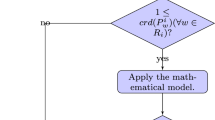Abstract
With the development of multimedia group applications and multicasting demands, the construction of multicast routing tree satisfying Quality of Service (QoS) is more important. A multicast tree, which is constructed by existing multicast algorithms, suffers three major weaknesses: (1) it cannot be constructed by multichannel routing, transmitting a message using all available links, thus the data traffic cannot be preferably distributed; (2) it does not formulate duplication capacity; consequently, duplication capacity in each node cannot be optimally distributed; (3) it cannot change the number of links and nodes used optimally. In fact, it cannot employ and cover unused backup multichannel paths optimally. To overcome these weaknesses, this paper presents a polynomial time algorithm for distributed optimal multicast routing and Quality of Service (QoS) guarantees in networks with multichannel paths which is called Distributed Optimal Multicast Multichannel Routing Algorithm (DOMMR). The aim of this algorithm is: (1) to minimize End-to-End delay across the multichannel paths, (2) to minimize consumption of bandwidth by using all available links, and (3) to maximize data rate by formulating network resources. DOMMR is based on the Linear Programming Formulation (LPF) and presents an iterative optimal solution to obtain the best distributed routes for traffic demands between all edge nodes. Computational experiments and numerical simulation results will show that the proposed algorithm is more efficient than the existing methods. The simulation results are obtained by applying network simulation tools such as QSB, OpNet and MATLB to some samples of network. We then introduce a generalized problem, called the delay-constrained multicast multichannel routing problem, and show that this generalized problem can be solved in polynomial time.
Similar content being viewed by others
References
Ahuja R, Magnanti T, Orlin J (1993) Network flows. Prentice Hall, Englewood Cliffs
AlWehaibi A, Kadoch M, Agarwal A, ElHakeem A (2004) Packet loss probability for diffserv over ip and mpls reliable homogeneous multicast networks. Inf Process Lett 90(1):73–80
Dijkstra E (1959) A note on two problems in connection with graphs. Numer Math 1(1):269–271
Feng G (2006) A multi-constrained multicast qos routing algorithm. Comput Commun 29(1):1811–1822
Ford LR, Fulkerson DR (1958) Constructing maximal dynamic flows from static flows. Oper Res 6:419–433
Ford LR, Fulkerson DR (1958) A suggested computation for maximal multi-commodity network flows. Manag Sci 5(1):97–101
Forsgren A, Pritz M (2002) Dimensioning multicast-enabled communications networks. Networks 39(1):216–231
Fortz MTB (2002) Optimizing ospf/is-is weights in a changing world. IEEE J Sel Areas Commun 20(1):756–767
Guo S, Yang O (2004) Qos-aware minimum energy multicast tree construction in wireless ad hoc networks. Ad Hoc Netw 2(1):217–229
Hac A, Wang D (1996) Congestion control with a multicast routing algorithm. Emerg Technol Appl Commun 1(1):70–73
Haghighat AT, Faez K (2003) Design of new real-time models for tight upper bound approximation of cell loss ratio in atm networks. Comput Commun 26:1225–1239
Isazadeh A, Heydarian M (2008) Optimal multicast multichannel routing in computer networks. Comput Commun 31(17):4149–4161
Lina J, Changb RS (1999) A comparison of the internet multicast routing protocols. Comput Commun 22(1):144–155
Matrawy A (2003) A rate adaption algorithm for multicast sources in priority-based IP networks. IEEE Commun Lett 7(2):94–96
Su CF (2000) High speed packet classification. In: Proceedings of IEEE GLOBCOM, vol 1, pp 582–586, November 2000
Thomas TI (1998) OSPF network design solutions. Cisco Press, Indianapolis
Tiwari A, Sahoo A (2007) Providing qos in ospf based best e.ort network using load sensitive routing. Simul Model Pract Theory 15(1):426–448
Wang Z (2001) Internet QoS: Architectures and mechanisms for quality of service. Networking. Morgan Kaufmann, Bell Labs, Lucent Technology, San Mateo
Wen UP, Wang WC, Yang CB (2007) Traffic engineering and congestion control for open shortest path. Omega 35(1):671–682
Xue GL (2003) Optimal multichannel data transmission in computer networks. Comput Commun 26:759–765
Author information
Authors and Affiliations
Corresponding author
Rights and permissions
About this article
Cite this article
Isazadeh, A., Heydarian, M. Traffic distribution for end-to-end QoS routing with multicast multichannel services. J Supercomput 52, 47–81 (2010). https://doi.org/10.1007/s11227-008-0263-4
Received:
Accepted:
Published:
Issue Date:
DOI: https://doi.org/10.1007/s11227-008-0263-4




